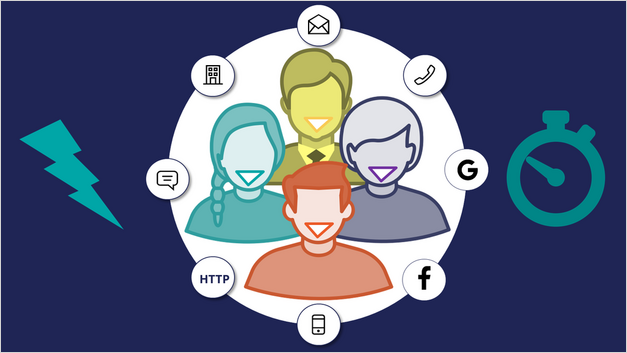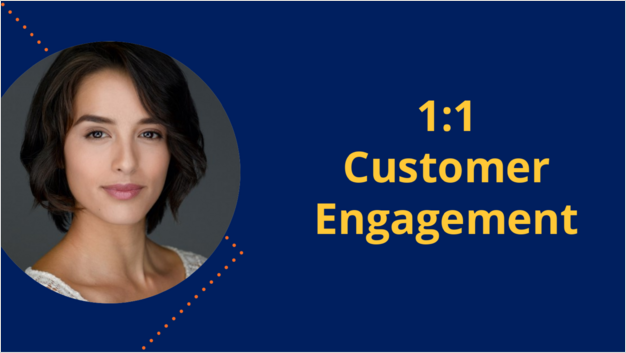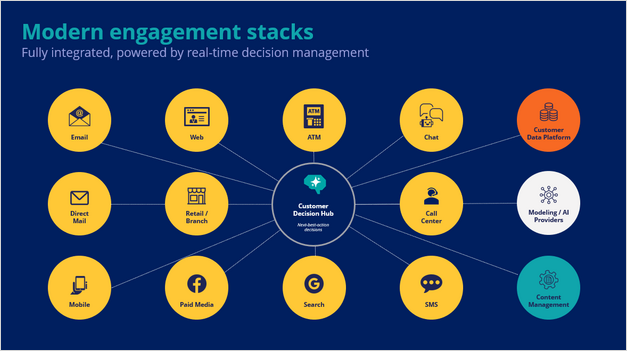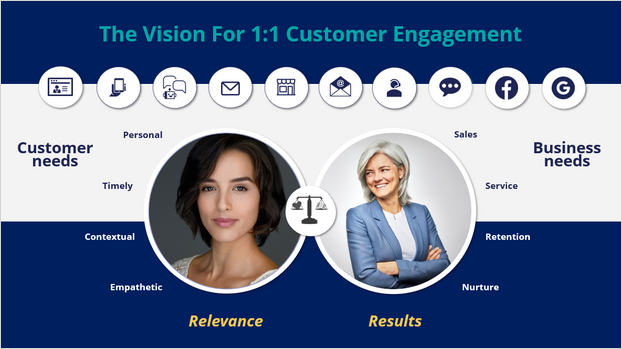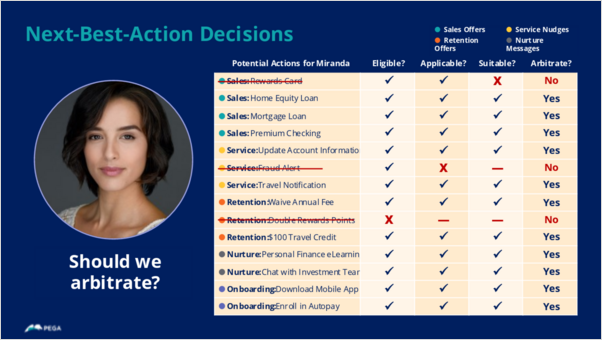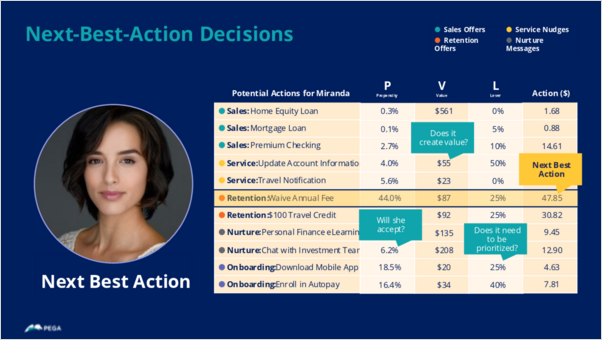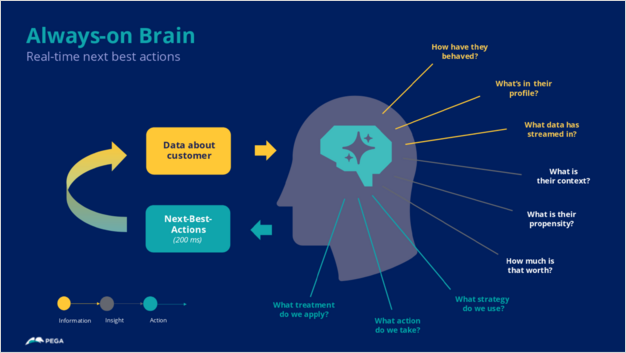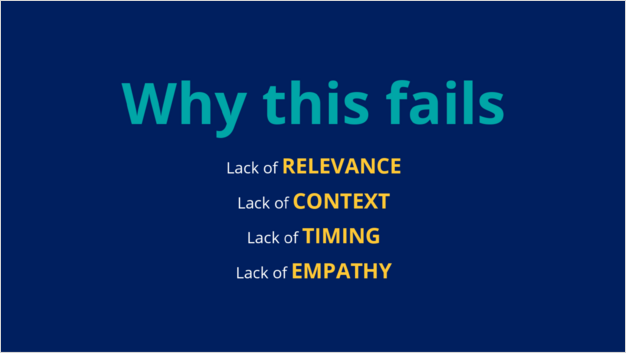
One-to-one Customer Engagement paradigm
Introduction
The optimal outcome of every customer interaction is to provide a great experience while maximizing the value of the customer to the company. To achieve this outcome, you must perform the right action in the right channel at the right moment for each customer. In Pega Customer Decision Hub™, this feature is known as One-to-one Customer Engagement.
Video
Transcript
The optimal outcome of every customer interaction is to provide a great experience while maximizing the value of the customer to the company.
In a traditional approach marketers search for potential customers from a database based on target demographics, geographies, or financial means to make a purchase. Then, marketers target this customer segment across all channels, and all these customers receive offers for a specific product.
The problem with this approach is that only a low percentage of customers respond or make a purchase. Marketers might hit their short-term goal, but in the long term, this approach affects the relationship with customers.
As a result, the traditional marketing approach fails because of a lack of relevance, context, timing, and empathy.
Customers are more empowered than ever before. As a result, they have very high expectations for the experiences they receive from their service providers. Their experiences must make sense within the context of their lives and this means they must be meaningful, consistent, and personalized across every channel with which they interact.
In business, the optimal outcome of every customer interaction is to provide a great experience while maximizing the customer's value to the company. To achieve this, you must perform the right action in the right channel at the right moment for each customer.
Traditional mass-marketing techniques that use segments, batches, and campaigns do not move the needle anymore; they are antiquated and unsustainable. The market has recentered around real-time technologies and one-to-one customer interactions.
The Pega approach to these interactions is through One-to-one Customer Engagement.
Through One-to-one Customer Engagement, companies can transition their marketing away from a traditional one-to-many campaign-driven approach. A one-to-one approach allows companies to have consistent, contextual, and relevant conversations with individual customers across any channel or touch point.
The key to achieving One-to-one Customer Engagement is one centralized brain.
In other words, one piece of intelligence acts as a single decision authority across your application ecosystem.
Each channel or system profits from this single source of customer intelligence and can use it to gain insights or perform relevant actions.
In Pega Customer Decision Hub, this centralized brain is the core feature that uses AI to enable One-to-one Customer Engagement.
In Pega Infinity, Pega Customer Decision Hub forms the core of the customer engagement platform, which sits at the center of existing systems and channels in an enterprise.
The "brain" collects data from every customer engagement across the enterprise to create predictions and decisions about every interaction in every channel.
Pega Customer Decision Hub can directly integrate with third-party content management platforms such as Adobe Experience Manager and use the content that you develop in these platforms for personalized customer engagement.
Continuous learning and decision-making are the foundation of a One-to-one Customer Engagement solution.
Customer Decision Hub combines analytics, business rules, customer data, and data collected during each customer interaction to create a set of actionable insights that it uses to make intelligent decisions. These decisions are known as the next best actions.
Every next best action weighs customer needs against business needs to optimize decisions based on priorities set by the business manager.
In the milliseconds before interacting with a customer, Customer Decision Hub combines thousands of business rules and predictive and adaptive models that determine customer needs and interests to ensure the next best action is relevant by keeping it personal, timely, contextual, and empathetic.
Customer Decision Hub identifies the best moments to make a sale, provide a service, make a retention offer, inform about an offer, or do nothing at all (for example, if no offer is relevant enough to warrant the customer's attention). The system distributes next-best-action decisions in real time to your channels, such as the web, mobile, and contact center. Pega Customer Decision Hub can also distribute next best actions to real-time paid channels such as Google, YouTube, Facebook, LinkedIn, and Instagram. Pega Customer Decision Hub also integrates with non-real-time outbound channels such as data management platforms (DMPs) and email.
After the system distributes the next best actions and the "brain" receives customer responses, the process begins again. Customer Decision Hub distributes new next best actions in milliseconds. It captures every customer interaction in every channel to ensure consistency and an optimized customer experience across channels.
For example, consider a customer, Miranda. With the centralized brain in place, instead of looking only at sales offers, the system begins with a list of all potential actions, such as service, retention, nurture, or a hardship message, everything that you can do for this customer now.
Although AI drives the next best actions, AI does not run rampant; it experiments on every person with every topic. Customer Decision Hub still allows marketers to maintain control and establish the criteria that AI must meet to consider beginning one of these conversations.
For example, you establish eligibility rules that state the business cannot sell a card to someone under the age of 18.
Then there are applicability rules to define if the action is appropriate at a given time. If Miranda already owns a competing or more valuable product, the business does not offer this product to her even though she is eligible.
Suitability rules determine whether an action is in the best interest of a customer. For example, Miranda might be eligible for a card, and her current card does not offer as high of a cash-back offer. But because Miranda cannot make her monthly payments and might end up in collections, the business does not offer the card to her even though it can.
So, if a customer fails to meet the conditions that you establish for an action, the AI does not consider that action.
Once the system narrows down the list, AI takes over. AI first determines how likely each action is desirable to the customer. Next, it determines the value each option generates for the business. What is the impact if the customer reads the content or accepts an offer? Does it give you more revenue or reduce your costs?
You can add levers to make adjustments based on the current business situation. For example, the business can decide to nudge an offer if it needs to meet its financial goals or ramp down an offer if it runs low on inventory.
For Miranda, the action that the system selects as the next best action is the one with the highest P*V*L value.
In summary, Customer Decision Hub is the always-on brain that acts as a single, centralized decision authority.
It uses data about the customer, including past interactions, as input.
It uses advanced AI techniques to make predictions.
Decision strategies (which combine traditional business rules with predictive, adaptive, and text analytics) deliver consistent and personalized next best actions across all channels.
You have reached the end of this video.
This Topic is available in the following Modules:
If you are having problems with your training, please review the Pega Academy Support FAQs.
Want to help us improve this content?

